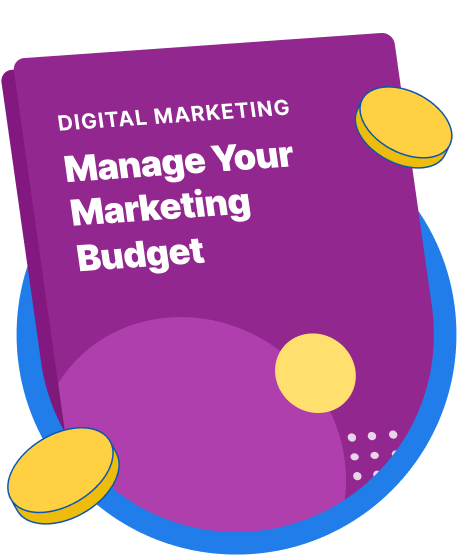-
 Published: Nov 21, 2021
Published: Nov 21, 2021
-
 9 min. read
9 min. read
-
 Matthew Gibbons
Matthew Gibbons Lead Data & Tech Writer
Lead Data & Tech Writer
- Matthew is a marketing expert focusing on the SEO & martech spaces. He has written over 500 marketing guides and video scripts for the WebFX YouTube channel. When he’s not striving to put out some fresh blog posts and articles, he’s usually fueling his Tolkien obsession or working on miscellaneous creative projects.
What is marketing collateral?
While you’re scrolling through social media, you run across three different posts from three different companies, none of which you know. The first two are ads attempting to push products on you, but the third is simply a link to a helpful blog post.
Out of those three posts, which one will earn the click? Most likely the third one. Given that you’ve never heard of any of these companies, you may not be interested in buying from any of them right now. But a simple, informative blog post? Sure!
That’s the idea behind marketing collateral. When you’re first introducing yourself to your audience, you want to use more informative content to earn their trust and pique their interest.
What is collateral in marketing, though, and how can you benefit from it? Read on to find out. Then subscribe to Revenue Weekly for more digital marketing tips from the agency with over 28 years of experience!
The marketing collateral definition: A term referring to marketing materials used to promote your business. Specifically, though, it relates to content-based materials.
So, if you run a paid ad that pushes users to make a purchase, that doesn’t fall under marketing collateral. Instead, marketing collateral would be something like a newsletter or article — something that promotes your business but does so in an informational way.
As far as marketing strategies go, this means that marketing collateral is essentially a form of content marketing. You can get it to users through various methods — ranking it in search results, sending it in emails, posting it on social media — but it always retains that content-based element.
Why do you need marketing collateral?
Marketing collateral is so useful because it can help you reach the people that aren’t ready to buy yet.
You can benefit from marketing collateral at almost every stage of the marketing funnel, but it’s especially advantageous for people who haven’t heard of you before. It’s extremely unlikely that those people will make a purchase right out of the gate, but they will be willing to read some content.
Even at other stages of the marketing funnel, marketing collateral is excellent for helping you establish credibility for your brand. When you spend a lot of time talking about the finer points of your industry, it shows that you’re an expert, making people more likely to trust you.
Types of marketing collateral
There are different types of marketing collateral suitable for traditional or internet marketing. These ensure you can address and satisfy the needs of your entire customer base and maximize the results of your marketing campaigns.
There are two main types of marketing collateral: print and digital. Each has smaller subsets, as you’ll see below.
Print marketing collateral
Print marketing collateral are tangible assets you publish on paper and distribute physically or display in-store or in public spaces, like community noticeboards, libraries, cafes, and gyms.
Digital marketing collateral have overridden their use. However, small and medium-sized businesses still use them to promote their brands in local communities. Large corporations use them at trade shows and conferences.
Below are examples of print marketing collateral:
- Brochures: These are tri-fold pieces of paper that contain an overview of your business and offerings. You can distribute them to customers in person or leave them in brochure stands for interested customers to collect at their convenience.
- Flyers: They’re a muted version of the brochures that use a single A4 or A5 size page with minimal copy printed on either or both sides. You can hand them out in malls or sidewalks to promote an event, product, or service.
- Posters: These are attention-grabbing marketing materials displayed on notice boards or in-store. They include eye-catching graphics and detailed copy that encourages passers-by to attend an event or make a purchase. You can also include a QR code to direct customers to a landing page.
- Business cards: These are an effective way of providing interested parties with your contact information anywhere at any time. Well-designed business cards include your company logo, business name, and contact information. They also fit your business’s aesthetics and are done in clear and legible fonts.
Digital Marketing Materials
Digital marketing materials are digital assets you can use for Internet marketing. In this digital age, SMEs and large corporations prefer to use them to inform, engage, and communicate online.
Digital marketing materials are diverse, and you can distribute them in different ways through multiple channels. Below are top examples of digital marketing collateral:
- Website content: Your website needs to be the one-stop shop for all your company information and product descriptions. It should have a cohesive design that communicates consistent brand messaging, and must be easy to navigate.
- Blog posts and long-form content: One of the most common types of marketing collateral is blog posts and long-form content. This content involves writing pages on your website to draw in users.
Blog posts are fantastic for attracting first-time site visitors.Let’s say you provide pest control services. You could write a blog post on how to prevent pests in your home. That’s something people often look up, and when they find your post, they’ll establish a connection with your brand.
Long-form achieves a similar purpose by covering various topics in your industry with the purpose of educating users. This content goes more in-depth than blog posts, so it’s a great option to provide a lot of information about a topic.
- Ebooks: Blog posts and long-form content are excellent for attracting first-time readers. But for people who are deeper in the marketing funnel and have already established an interest in your content, you can aim to provide even larger pieces of content, like ebooks.
Ebooks tackle similar content to long-form pieces, but provide a much more in-depth look at the subject matter. Rather than putting this up on your website, you can offer ebooks to users who wish to sign up for your emails or possibly even purchase the books.
- Case studies: Few forms of marketing content are more likely to convince users of your credibility than direct evidence of how you’ve helped your past customers. That’s why case studies are so valuable.
This type of marketing collateral is most valuable for businesses that offer services rather than just products, particularly business-to-business (B2B) companies. You can write case studies to explain what you’ve done for your past clients and how it helped them.
With case studies, you still get to talk about your services, but it’s in an informational way. Furthermore, you get to demonstrate to your audience exactly what you’re capable of doing for them.
- Newsletters: In today’s world, the best way to send out newsletters is by email, though you can also post them on your site for everyone to see if you choose.
Newsletters offer information relevant to your industry. Your newsletter should primarily point users to helpful information in the industry, much (or all) of which can come from your blog or website. Additionally, you can provide a bit of information about the latest news within your company.
You can offer newsletters on your site, and users can submit their email addresses to sign up for them. That way you can establish a link to your target audience right in their inbox! Whether sent out by email or posted on your website, you can use newsletters to share company news, promote new products and services, or offer industry information. They should include clear call-to-actions (CTAs) that guide readers to complete desired actions.
Watch this video to learn more about newsletters and email marketing:
- Social media graphics: You can use social media posts, stories, and graphics to share information or promote your products, services, and events. Social media is a great way to start conversations, engage in meaningful dialogue, and showcase your brand personality.
- Infographics: These effectively display complex information in a scannable, easy-to-digest format that encourages people to share online. They combine text, images, icons, charts, widgets, and graphics to capture the audience’s attention more effectively than plain text. If you haven’t used any infographics in your marketing before, try it out — they can be incredibly effective! The reason for that is because they’re very visual, meaning they’ll draw users in, but they’re also packed with useful information.
Infographics are helpful for reaching people who might not want to read paragraphs of plain text. If those people see an infographic, they’ll be drawn in by the images and colorful designs, and still get valuable information in a format easier to digest than a full blog post.
You can display infographics in various places, including your website and different types of social media.
- Videos: These are effective because they are versatile and highly engaging. You can use videos to educate, inform, or entertain your audience by combining visuals, audio, and text. Ensure your videos are high-quality, short, concise, and relevant to your audience to get the most engagement.
How to create effective marketing collateral
Marketing collateral aim to show your brand in the best light while promoting your products and services. Hence, they must be well-designed and aligned with your brand messaging to deliver the intended results.
Here are some tips for creating effective marketing materials:
- Understand your audience and craft your marketing materials to resonate with them and address their needs and pain points.
- Pair informative text and captivating visuals to differentiate yourself from competitors and ensure your brand message spreads far and wide.
- Ensure your messaging is clear and accurate. Use a language that’s relevant and relatable to your audience—spell out who you are, what you do, and why it is essential to them.
- Always include a CTA that lets your audience know what to do after encountering your marketing materials.
WebFX can boost your content marketing strategy to new heights
Ready to kick your marketing collateral into gear? WebFX would love to help you! We’ve earned over 1,100 client testimonials speaking to our expertise and professionalism in digital marketing.
With our content marketing services, you can get help creating each of the types of content above and more. We can also help you send emails and perfect your search engine optimization (SEO) to get your content where users can see it.
To get started with us, just call 888-601-5359 or contact us online today!
-
 Matthew is a marketing expert focusing on the SEO & martech spaces. He has written over 500 marketing guides and video scripts for the WebFX YouTube channel. When he’s not striving to put out some fresh blog posts and articles, he’s usually fueling his Tolkien obsession or working on miscellaneous creative projects.
Matthew is a marketing expert focusing on the SEO & martech spaces. He has written over 500 marketing guides and video scripts for the WebFX YouTube channel. When he’s not striving to put out some fresh blog posts and articles, he’s usually fueling his Tolkien obsession or working on miscellaneous creative projects. -

WebFX is a full-service marketing agency with 1,100+ client reviews and a 4.9-star rating on Clutch! Find out how our expert team and revenue-accelerating tech can drive results for you! Learn more
Try our free Marketing Calculator
Craft a tailored online marketing strategy! Utilize our free Internet marketing calculator for a custom plan based on your location, reach, timeframe, and budget.
Plan Your Marketing Budget

Maximize Your Marketing ROI
Claim your free eBook packed with proven strategies to boost your marketing efforts.
Get the GuideTry our free Marketing Calculator
Craft a tailored online marketing strategy! Utilize our free Internet marketing calculator for a custom plan based on your location, reach, timeframe, and budget.
Plan Your Marketing Budget





